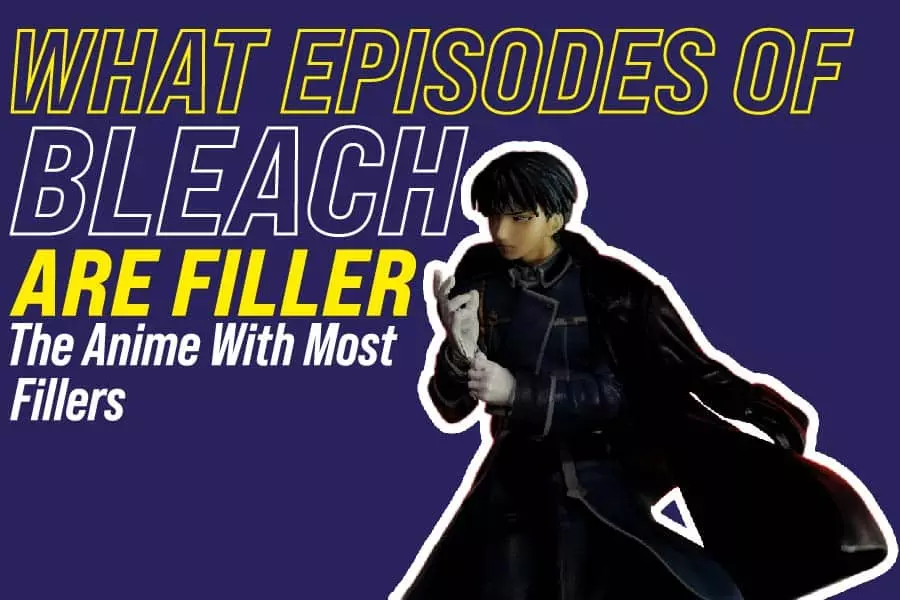Almost all the long-running anime series usually add arcs or filler episodes during their initial run.
The role of the filler episodes is to expand the story. However, most fillers do not directly relate to the main narratives, which is why fans hate them.
Filers are quite common in manga anime because of the delays in the publication of the manga anime or no other manga storyline. The animators use the fillers till the content is available.
The bleach is one of the anime that is notorious for its fillers. Therefore, this article will help you know the bleach episodes that are fillers. Let’s start by answering the common question.
What Episodes Of Bleach Are Filler?
People love watching the whole anime to experience everything. However, the fillers are usually distracting and boring, and people tend to skip them.
The bleach anime is quite popular with a total of 366 episodes, the filler episodes are 144, and this is too much.
The Bleach Filler List Guide
The bleach anime ended in 2012 and has 366 episodes. The anime does follow almost the whole manga.
In bleach, 163 episodes out of the 366 episodes are fillers, equating to 45% fillers; this; this is nearly half the show. Here is a list of the bleach episodes that are fillers.
- 33
- 50
- 64-109
- 128-137
- 147-149
- 168-189
- 204-205
- 213-214
- 227-266
- 287
- 298-299
- 303-305
- 311-342
- 355
Can You Skip The Bleach Fillers
The BleachBleach anime series is Japanese and has aired from 2004 to 2012. The series is an adaptation of the popular Taite Kubo manga series. However, most of the bleach series adapts the Kubo manga.
The series aired for ten years and has 366 episodes. It’s TV Tokyo that aired the original anime, and Noriyuki Abe directed it. The best way to watch the bleach anime without the fillers is by removing the five original filler arcs.
But this will reduce the episodes to 203. As mentioned, bleach features are among the animations that have the most fillers. People wonder whether watching the additional 163 episodes that do not relate to the story is worth it.
The bleach fillers aren’t masterpieces, and therefore you can skip them. The most skippable is the filler arc, but you need to know that you will have very few episodes to watch.
Are The Bleach Fillers Worth Watching?
The fillers take up to 45%, which is almost half the whole anime. You might wonder whether it’s worth spending hours watching material that doesn’t relate a lot to the main story.
Most bleach fans say the fillers are not that interesting and do not add a lot to the story. If you want to perceive the whole story behind the bleach anime, you can watch everything. But if you are wondering whether the fillers are worth watching – they aren’t.
How Long Does It Take To Watch Bleach
The bleach is a very special anime, and to start watching from episode one, you need to be prepared. The anime did start in 2004 and was around for eight years until 2012.
The anime has amazing adventures, and it’s a great one to watch despite the huge number of fillers. A single bleach episode lasts somewhere between 22 to 24 minutes.
The time calculation will include the filler episodes. The anime has a total of 366 episodes, and each takes approximately 24 minutes.
It means to complete all the 366 episodes, you’ll need 8,784 minutes which equates to six days, two hours, and 24 minutes or 146 hours, 24 minutes.
What Makes Bleach anime Long?
Their bleach anime is long, but there are other longer anime series. The bleach is long because it was a weekly manga. It means it was to last as long as it’s popular and there are fans to read it.
After the series introduction, it became so popular in Japan and the rest of the world. The authors had enough time to tell their stories to completion. These are the reasons why bleach is longer than other anime and manga series.
The Anime With Most Filler
People do not love the filler in anime, even though some are usually interesting. The number of fillers does vary from anime to anime. In this list, you will learn about the anime with the most filler. You will surely find your favorite anime on this list.
The information on the list is the best and most accurate, but you should know that the filler numbers will change; that’s for the ongoing anime.
- Trigun: The anime has 26 episodes and 17 fillers which equates to 65%. The anime has the highest filler percentage.
- Black Butler: The anime has 46 episodes and 29 fillers; thus, the fillers are 63%.
- Hayate the Combat Butler: It has 35 episodes and 21 fillers, and therefore its filler percentage is 60%.
- The Love Ru: The anime has 38 episodes and 21 fillers which are 55%.
- The Sailor Moon: The anime has 200 episodes and 98 fillers, which equates to 49%.
- The Hellsing: The anime has thirteen episodes and six fillers that make 46%.
- Bleach: The article is about the fillers in bleach anime. The anime has 366 episodes and 164 fillers, and this is 45%. You have already read much information about anime in the article.
- Ranma ½: The Ranma ½ anime has 161 episodes and 72 fillers, equating to 45%.
- Detective Conan: It is the anime with the most filler in history; the anime has 1014 episodes and 440 fillers. The filler percentage is 43%.
- Rosario + Vampire Filler: The anime has 26 episodes, which brings the filler percentage to 42%.
The Filler Arcs To Skip In Bleach
The filler arcs are common in anime, and bleach is among the anime with most filler arcs. The show is long-running, and this makes it hard for its directors to avoid fillers.
The issue about fillers is that they do not relate to the main story and influence character development.
1. An Episode To Skip: Gotei 13 – Gathering In The Real World
Truly, the episode is a classic build and has several moving pieces and a lot of talk time—all these help to set up the next part of the anime.
In this series, there is Inaba plus his army of the Reigai copies. The episode does have a build-up, but the only important thing in the episode is the nearly killing of Nozomi.
The other thing is that Kon and Nozomi become friends; this is the best part of the arc.
2. Gotei 13 – Invading Army
The episode has several ups and downs and a lot of focus on mod souls. Urahara and Mayuri can only understand the pseudoscience in the episode.
The other thing is that Inaba tries to fuse with Nozomi; this allows them to become their original self. It was a man known as Yushima. The other part of the story is lackluster.
Overall most of the story is about Nozomi and how she interacts with others. Nozomi is surely an interesting character; all rounded and has a nice ending.
3. Desperate Struggle Under The Moonlight
Through the episode, the directors introduce the human side of the storyline. However, Amagai is a very cheap imitation in this episode and quite far from the arc’s weakest part.
4. New Captain Shunsuke Amagai
People find this arc to be annoying because of certain reasons. The first reason is that the episode comes after Ichigo and Grimmjow’s final battle; it messes up the story.
The other thing is that the arc is not simply great and is the weakest among all the bleach filler. The only positives in the filler are a perfect build-up of Kira’s character and the final battle with Amagai.
5. Bount
According to history, the bount are vampires that lived years ago. The vampires were able to live long lives by absorbing others’ souls. The concept was great and quite interesting.
The episode also brought the trio of KurodaKuroda, Noba, and Ririn; they were so entertaining. The one thing that makes the filler boring is Ichigo does most of the fighting. Therefore the character loses the fights repeatedly.
Conclusion
The bleach anime is one of the many manga series and anime that deal with Shinigami. The story is actually about a concept of a soul reaper (death god).
Those who have watched the full anime know how completing the whole manga series is hard. The fillers are the reason why watching the anime is hard.
Fillers episodes are present in the anime but do not appear in the original manga. The fillers are usually added for specific practical reasons, such as the manga running late or the anime has already adapted all the published stories up to a certain part.







